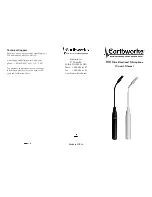
4. The R-101 requires no power supply and is safe to use on consoles with phantom
microphone powering, provided that the cabling is wired properly. It should be noted that not
all ribbon microphones are compatible with phantom-powered systems, so check the
manufacturer’s recommendations before using other ribbon microphones. It should also be
noted that faulty or improperly wired cables could cause problems with your R-101. Do not
patch an R-101 through the mic tie lines of a patch bay if phantom power is enabled on any
of your mic pre’s, as this will give the ribbon element a brief but damaging phantom power
jolt.
5. Never attempt to test the R-101 or any ribbon microphone with an ohmmeter. A blown ribbon
could result.
6. Always provide adequate protection for your R-101, or any ribbon microphone. If the
microphone is to remain set up on a stand when not in use, place a mic sock (supplied with
every Royer microphone) over it until it is to be used. Do not carry the microphone around
without placing a mic sock over it. Failure to follow this commonsense practice may yield a
stretched ribbon and compromised performance.
7. Do not allow the microphone to be dropped on hard surfaces such as floors or tables -
depending on how the mic falls, you could stretch the ribbon. The microphone would likely
continue to operate, but performance could be compromised and re-ribboning the
microphone would be necessary to restore normal operation.
Amplification Considerations
The performance of any non-active ribbon microphone is directly affected by the microphone
preamplifier it is paired with. With so many mic preamps on the market, how do you select one
that gives the best possible performance with a ribbon microphone? Additionally, what kind of
performance can you expect from the preamplifiers built into your mixing desk? While most
preamplifiers will handle ribbon microphones well in most recording situations, some preamps
that work perfectly well with condenser or dynamic mics may prove to be poor performers with
ribbons.
To begin, we must understand the fundamental differences between ribbon microphones and
other popular types, namely condenser and moving coil dynamics. A ribbon microphone is
actually a dynamic microphone that uses a corrugated, extremely low mass ribbon element,
rather than a coil/diaphragm assembly. For this writing, any mention of dynamic microphones
will relate to moving coil dynamics.
All condenser microphones have a built-in preamplifier called a head amp, and therefore put out
a hefty signal. Because the signal is buffered through the head amp, the output impedance is
rather low and less affected by the input impedance of the microphone preamp. Most dynamic
(moving coil) microphones generate a healthy enough electrical current to work well with a
5
Содержание R-101
Страница 18: ...Polar Pattern Frequency Response 18 ...



































